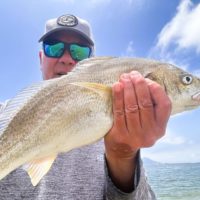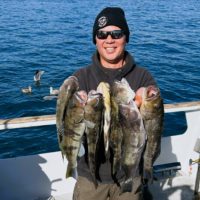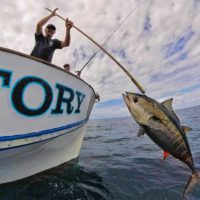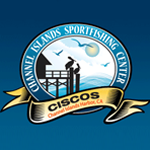
Driving down to Gonzaga from San Felipe was a pleasant drive, especially for Baja California. Federal Highway 5 is a somewhat newly renovated road. Dennis told me it had washed out a few years ago and required some off-roading in order to get down to Gonzaga by this route. The alternative, driving from Ensenada through the interior would have taken hours longer.
Around Puertocitos, we could see the water again. There were little islands that dotted the water. Actually, it was hard to tell if they were islands, or just part of the land with the mirage of the sky reflected on the land below. As we got closer, we could tell they were indeed islands. We encountered a LA POMA sign (above) just before we got to Gonzaga. Dennis wanted to stop and take a picture. I asked him what La Poma was…is it a town? Some sort of landmark? Dennis didn’t know. He took his picture and we were quickly back on the road.
I didn’t think anymore about it. The excitement of finally making it here and the opportunity to fish it dominated my thoughts.
Day 1 did not disappoint. If you missed that article, read it HERE.
Day 2 started similarly to Day 1. We met up with George at 6am. Our gear was already on the boat, so we were quickly on the water. Our take home cooler was already stuffed with the bounty of Day 1, so we let George know we weren’t interested in taking home anymore fish. We just wanted to target grouper.


As we were motoring out of the little cove where Papa Fernandez is located, George pointed out a cabrilla spot that he had success with last year. He said that if the right situation comes up he’d let us know, but that right now the water was still too cold for successful cabrilla fishing.
I was disappointed to hear that. When the grouper fishing didn’t pan out last September in BoLA, we had cabrilla fishing to fall back on. I have to say it just may be one of my favorite things to do. Too bad it didn’t appear as if it would be on the menu today.
NOTE – They call a lot of things cabrilla in Baja California…everything from leopard grouper to calico bass.

We made our way toward what George told us were collectively known as the Enchanted Islands (Islas Encantadas)…the little group of islands (really just rocky outcroppings) near shore that we saw from the highway. They were just north of our launch area.
The gameplan for today was basically the same as Day 1…follow the birds, try to make some bigger baits for grouper, hopefully get the big bite and land our target quarry.

George explained that the bait the fish are foraging on are very small, anchovy-sized fish. He suggested rigging up an 80 or 100 gram colt sniper/megabait/zakana-type jig to match-the-hatch.
Knowing that sierra mackerel have very sharp teeth, I asked if I should wire the jig. George said no. He said sometimes he loses 5 jigs in 20 minutes and sometimes he goes all day never changing one out. He said it bit better without the wire…losing the occasional jig was just part of the game. He said he mitigates the loss of jigs by buying cheap knockoffs (like Caivos…good to know for future reference). I tied on an 80 gram Katy Perry zakana on my light jig setup (see below).
On our way out, we saw birds working outside. We looked at each other and shared a laugh. Have fun kids. See you again another time.
As we approach the islands, we see some birds working and slide-in to throw on them. Dennis was immediately bit, and just that fast was no longer tight. He reeled in to find his line sheared-off clean. Sierra mackerel. The birds moved on.
While Dennis re-rigged, we chased another school of birds. This time it made the birds of yesterday look tame by comparison. The sky was literally falling all around us. A combination of boobies and pelicans are dropping out of the sky in fast succession.
This time the catching is full-speed. Everything is good and lathered up and wanting to bite. The light jig is so perfect for this application. You can burn it on top. The only problem with doing that is the birds are all over it. You can let it sink a little and use it as a sub-surface type of lure. Or you can sink it all the way to the bottom and catch the golden-spotted bass. Just be careful. The terrain below was very catchy.

I’ve caught sierra mackerel before. It’s actually my all-time favorite ceviche fish. The quality on these Gonzaga ones though was outstanding. Dennis wanted to take a couple for a friend who specifically requested sierra, so we threw a couple of the bigger ones in the cooler to take. A few of the smaller ones went into the bait tank to use for bait, along with one small yellow and some golden-spotted bass. We ended up releasing a bunch of fish because the catching was too much fun.
Now that we had bait, we turned our attention to what we had originally come here for…trying to catch a really large gulf grouper. Dennis is anti-bait fishing in general, but even he was down with this program if it would get him his grouper.
I prepared my heavy setup (see below). I still had some of the pre-made heavy leaders I used at BoLA when I was trying to do the same thing. I tied my 100# braid to 100# mono (shock leader) mainline to the heavy duty double swivel attached to the leader and ran 30# mono from the bottom of the swivel to a 16-ounce torpedo. The leader itself was 200# fluorocarbon. George pinned on the little yellow saying it would most definitely get bit.
It did alright, just not by the right creature.

Damn sea lions. Everywhere I fish, from the Pacific Northwest to deep in the Sea of Cortez, they’re that annoying guest you just can’t shake. That was the one candy bait we had. We’d have to try and make due with either sierra or golden spots. The golden spots we had in the tank weren’t looking too lively, so we both decided to go with sierras. We were going to move and try the same drift again when George said to grab our jig sticks.
The cabrilla condition that George was looking for was if the birds were working on a high spot. He said when you have that combination of activity on structure, even the golden spots would come up and boil on the surface. I had earlier spotted a boiler rock that was randomly on its own away from the structure close to the islands. Right now, the birds were raining on that rock. Our chance to catch cabrilla was happening.

OMG that was fun. At one point, I saw one fly completely out of the water that missed my jig! It was really good for maybe 20 minutes before the birds decided to take their mid-afternoon siesta and completely disappear from the scene altogether.
We were running out of time, so we setup for a couple more drifts to end the day. We both managed to get bit, but neither fish stuck. We tried again, this time with George’s roided out trap rig setup (below). Close, but no cigar.

That was the trip. Funny how fishing goes. We didn’t come close to catching our target fish, but what a fantastic experience. Thanks to George Catian for sharing with us his expertise and providing the fishing opportunities we had. Fishing is unpredictable. As mentioned in the first article, George was booked out in Gonzaga for the whole month of April. He ended up running back to San Quintin though when the bluefin bite exploded before this last bout of wind we had. Hopefully, we can catch up with him again in the future and be ready for what the sea has to offer.
What was the Mystery of La Poma you ask?

While we were fishing next to one of the little Enchanted Islands, I saw what looked like the unwelcome output of the head on a party boat.
I knew that wasn’t the case on the panga, so I asked George what it was. Floating rocks. What do you mean floating rocks? Turns out that La Poma is one of the islands…the one entirely made up of pumice…the volcanic rock filled with air.

www-fishingsyndicate.com – USE COUPON CODE SOCALSALTY10 for a 10% discount











No Comments